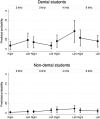Increased Signs of Noise-Induced Hearing Loss in Dental Students: A Multilevel Approach
- PMID: 36124524
- PMCID: PMC9743310
- DOI: 10.4103/nah.nah_21_21
Increased Signs of Noise-Induced Hearing Loss in Dental Students: A Multilevel Approach
Abstract
Context: Despite the fact that the new generations of rotary tools emit less noise, some recent studies suggest that dental students are still at risk of hearing impairment.
Aims: The aim of the study was to determine a possible association between noise exposure from dental equipment and early signs of noise-induced hearing loss (NIHL) in dental students.
Settings and design: A cross-sectional study was carried out with dental and non-dental students from two universities in Chile.
Methods and material: A group of 102 dental students routinely exposed to noise emitted from dental equipment was selected as the study group. A group of 251 non-dental students was selected as the control group. Pure-tone audiometry was carried out on all participants ensuring that they were not exposed to noise for at least 24 hours prior to testing. The presence of a notch was determined for each participant.
Statistical analysis used: Simultaneous-quantile regressions were used to compare percentiles of the hearing threshold between both groups. Then, the notch prevalence ratio adjusted by gender and age was estimated for each group of participants. Finally, the prevalence of an audiometric notch was compared between both groups using logistic regression models and generalized linear methods. Both fixed effect and multilevel hierarchy models were constructed.
Results: Significant differences between groups for the 75th percentile of hearing threshold distributions at 4 and 6 kHz in the left ear and at 6 kHz in the right ear were found. In addition, study group participants exhibited a significantly higher prevalence of a notch at 4 kHz in the left ear than control group participants.
Conclusions: Exposure to noise derived from learning activities as a dental student is associated with early signs of NIHL. Such signs include poorer hearing thresholds than those of non-dental students at 4 and 6 kHz as well as the presence of a notch at high frequencies.
Keywords: Dental student; multilevel hierarchy models; noise-induced hearing loss; notch prevalence.
Conflict of interest statement
None
Figures


References
-
- Gijbels F, Jacobs R, Princen K, Nackaerts O, Debruyne F. Potential occupational health problems for dentists in Flanders, Belgium. Clin Oral Investig. 2006;10:8–16. - PubMed
-
- Wilson CE, Vaidyanathan TK, Cinotti WR, Cohen SM, Wang SJ. Hearing-damage risk and communication interference in dental practice. J Dent Res. 1990;69:489–93. - PubMed
-
- Rahko AA, Karma PH, Rahko KT, Kataja MJ. High-frequency hearing of dental personnel. Community Dent Oral Epidemiol. 1988;16:268–70. - PubMed
-
- Khaimook W, Suksamae P, Choosong T, Chayarpham S, Tantisarasart R. The prevalence of noise-induced occupational hearing loss in dentistry personnel. Workplace Health Saf. 2014;62:357–60. - PubMed
MeSH terms
LinkOut - more resources
Full Text Sources

